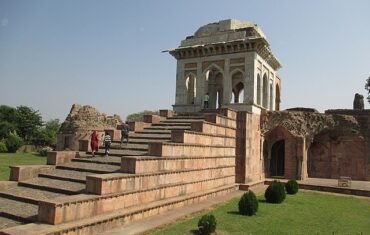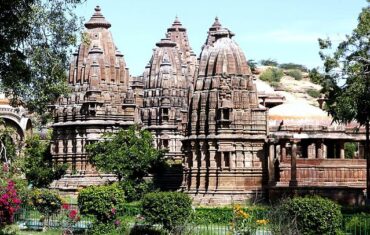Nageshwar Jyotirlinga is a Hindu temple dedicated to Lord Shiva and is one of the twelve Jyotirlingas, shrines which are said to be the most sacred abodes of Shiva. The temple is located in Dwarka, on the coast of Saurashtra, in Gujarat. The temple is also known for its scenic beauty and peaceful atmosphere, as it is surrounded by a large garden with a pond and a 25 m tall statue of Lord Shiva. Visit during One Day Dwarka Sightseeing Trip By Private Cab
Location of Nageshwar Jyotirlinga Temple

The Nageshwar temple is about 18 km (11 mi) from Dwarka city, which is well connected by flights, trains and buses from various cities in India. The temple can also be reached by road from nearby towns such as Jamnagar, Rajkot and Porbandar. The temple is located near the Arabian Sea and offers a splendid view of the sunset and the waves.
Timing of Nageshwar Jyotirlinga Temple
The Nageshwar temple is open for darshan (viewing) from 6 am to 9 pm every day. The temple has three aartis (rituals) daily: at 6 am, 12 pm and 7 pm. The temple also has a special aarti called Rudra Abhishek, which is performed at 4 pm using water, milk, honey, curd, ghee and other substances. This aarti is considered to be very auspicious and powerful, as it symbolizes the worship of Shiva as Rudra, the destroyer of evil. The temple charges a nominal fee for entry and photography.
Rituals of Nageshwar Jyotirlinga Temple

The Nageshwar temple has various rituals and ceremonies that are performed by the priests and devotees throughout the year. Some of the main rituals are:
- Abhishek: This is the ritual of bathing the idol of Shiva with water, milk, honey, curd, ghee and other substances. This is done to express devotion and gratitude to Shiva and to seek his blessings. Devotees can perform abhishek by themselves or by booking online through the temple website.
- Rudrabhishek: This is a special abhishek that involves chanting the Rudram, a hymn from the Vedas that praises Shiva as the destroyer of evil and the source of all creation. This is done to invoke Shiva’s grace and protection from all kinds of troubles and calamities. Devotees can perform rudrabhishek by themselves or by booking online through the temple website.
- Mahapuja: This is a grand puja (worship) that involves offering various items such as flowers, fruits, sweets, clothes and ornaments to Shiva. This is done to express love and reverence to Shiva and to seek his fulfillment of all desires. Devotees can perform mahapuja by themselves or by booking online through the temple website.
- Pradakshina: This is the ritual of circumambulating (walking around) the temple in a clockwise direction. This is done to show respect and devotion to Shiva and to imbibe his positive energy and vibrations. Devotees can do pradakshina as many times as they wish.
Importance of Nageshwar Jyotirlinga Temple

The Nageshwar temple is considered one of the most important pilgrimage sites for Hindus, especially for Shaivites (followers of Shiva). The temple has a long and rich history, with evidence of its existence dating back to ancient times. The temple has been visited and praised by many saints, poets and kings, such as Adi Shankara, Narsinh Mehta, Raja Bhoj and Raja Ranjit Singh.
The Nageshwar temple is believed to be the place where Shiva manifested himself as a Jyotirlinga, a pillar of light, to prove his supremacy over other gods. The temple is also believed to be the place where Shiva saved his devotee Supriya from a demon named Daruka. The temple is also believed to be the place where Shiva granted his devotee Bhima with a boon of strength after he defeated him in a wrestling match.
The Nageshwar temple is a symbol of faith, power and devotion for millions of Hindus across the world. The temple attracts thousands of pilgrims and tourists every year, who come to seek the blessings of Shiva and to witness the beauty and serenity of the temple.
Significance of Nageshwar Jyotirlinga Temple

The Nageshwar temple has a great significance for Hindus, as it represents one of the aspects of Shiva, the supreme god of Hinduism. Shiva is known by many names and forms, such as Mahadev (the great god), Nataraj (the lord of dance), Rudra (the fierce one), Neelkanth (the blue-throated one), Bholenath (the simple one) and many more. Shiva is also known as Nageshwar, which means “the lord of snakes” or “the lord of serpents”.
Nageshwar is the aspect of Shiva that symbolizes wisdom and protection. He is the master of snakes and serpents, who are associated with knowledge and healing. He is the lord of the underworld, who guards the secrets and treasures of the earth. He is the protector of his devotees, who shields them from all kinds of dangers and enemies.
The Nageshwar temple is dedicated to Shiva as Nageshwar, who is worshipped as the giver of knowledge, wealth and health. The temple is also dedicated to Shiva as Jyotirlinga, which means “the linga (symbol) of light”. A Jyotirlinga is a representation of Shiva’s infinite power and presence, which can be seen and felt by his devotees. A Jyotirlinga is also a manifestation of Shiva’s grace and compassion, which can heal and transform his devotees.
The Nageshwar temple is one of the twelve Jyotirlingas in India, which are considered to be the most sacred shrines of Shiva. Each Jyotirlinga has a different name and story associated with it, which reveals a different aspect of Shiva’s personality and attributes. By visiting and worshipping these Jyotirlingas, devotees can experience the various facets of Shiva’s glory and benevolence.
FAQ’s
How to reach Nageshwar temple?
The Nageshwar temple can be reached by road, rail or air. The nearest airport is Jamnagar airport, which is about 137 km (85 mi) away from the temple. The nearest railway station is Dwarka railway station, which is about 18 km (11 mi) away from the temple. The temple can also be reached by road from nearby towns such as Jamnagar, Rajkot and Porbandar.
When is the best time to visit Nageshwar temple?
The best time to visit Nageshwar temple is from October to March, when the weather is pleasant and comfortable. The temple can also be visited during festivals such as Mahashivaratri, Shravan Maas, Navratri and Diwali, when the temple is decorated and celebrated with great fervor and enthusiasm.
What are the other attractions near Nageshwar temple?
There are many other attractions near Nageshwar temple that can be explored by the visitors. Some of them are:
Dwarkadhish Temple: This is a famous temple dedicated to Lord Krishna, who is believed to have established his kingdom in Dwarka. It is one of the four holy places in India’s Char Dham pilgrimage circuit.
Bet Dwarka: This is an island that lies about 30 km (19 mi) from Dwarka city. It is believed to be the original residence of Lord Krishna and his family. It has many temples and archaeological sites.
Rukmini Devi Temple: This is a temple dedicated to Rukmini Devi, the chief consort of Lord Krishna. It is located about 2 km (1.2 mi) from Dwarka city and has exquisite carvings and paintings.
Gomti Ghat: This is a river bank that lies at the confluence of the Gomti River and the Arabian Sea. It has many ghats (steps) where pilgrims take a holy dip and offer prayers.
Conclusion
The Nageshwar Jyotirlinga is a sacred and serene temple that showcases the power and devotion of Hinduism. The temple is a testimony of the faith and courage of the Hindus, who have preserved and maintained the temple despite several challenges and calamities. The temple is a source of inspiration and solace for millions of pilgrims and tourists, who come to seek the blessings of Shiva and to witness the beauty and serenity of the temple. The Nageshwar Jyotirlinga is not just a temple, but a living legend that embodies the spirit and essence of Hinduism.











